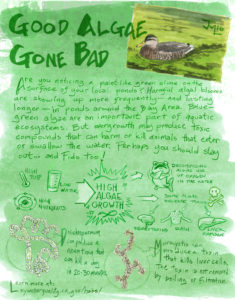In late August, California Department of Fish and Game environmental scientist Laura Rogers-Bennett was driving back to Bodega Bay after conducting ocean surveys in Mendocino when she saw “dark-coffee-colored water” north of Salt Point State Park. Within days, dead sea stars, abalones, urchins, and chitons were piling up on area beaches. By September 15, Fish and Game had closed the abalone season for the rest of the year. Apparently, a harmful algae bloom was poisoning the near-shore waters. In late September, Rogers-Bennett and her research team dove transects at three- to 60-foot depths at four sites along the Sonoma Coast, including Fort Ross, where they found 30 percent of abalone and 35 percent of sea urchins dead. At Timber Cove, they found 45 percent of urchins and 25 percent of abalone dead. Both species had higher mortality in shallower waters.
Rogers-Bennett and other researchers were able to identify the algae bloom thanks to water samples collected by Sonoma State University graduate student Adele Paquin, who happened to have taken daily samples in the surf zone for her thesis. Scientists now believe that the die-off was caused by an organism called Gonyaulax spinifera, a dinoflagellate known to occur off the Pacific Coast, but not known to kill sea stars, abalone, and urchins. Microscopic studies of Paquin’s water samples also revealed the possibility that two dinoflagellattes were part of the bloom, G. spinifera and an unnamed species of Gonyaulax. Scientists are still conducting genetic studies to confirm that the die-off was associated with the bloom, and if their suspicions are substantiated it will be the first scientifically confirmed algae-related die-off on the Sonoma Coast, says Rogers-Bennett.
For years, Paquin’s advisor, Sonoma State marine ecologist Karina Nielsen, has taken her students to Pinnacle Gulch in Bodega Bay to observe the area’s plentiful invertebrates. But on their last visit, they found only two sea stars. “The abalone is what gets in the news because of the human perspective, but from an ecological perspective, it’s the urchins and sea stars that are important to the diversity of the system. The urchins are what took it in the shorts.”
Rogers-Bennett says it’s not yet known what’s in store for the start of the abalone season on April 1, 2012. For updates, go to dfg.ca.gov/marine.

.jpg)
